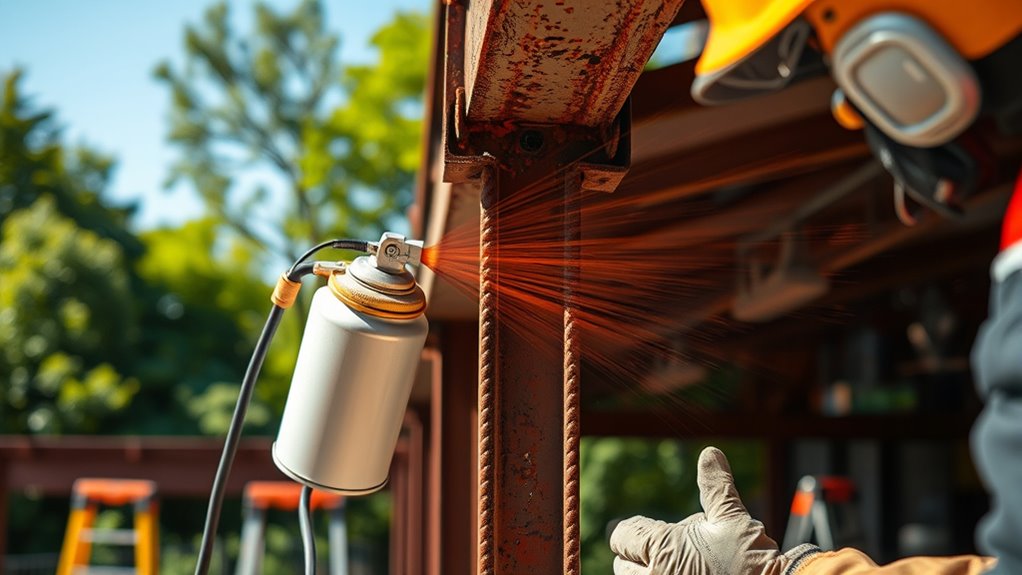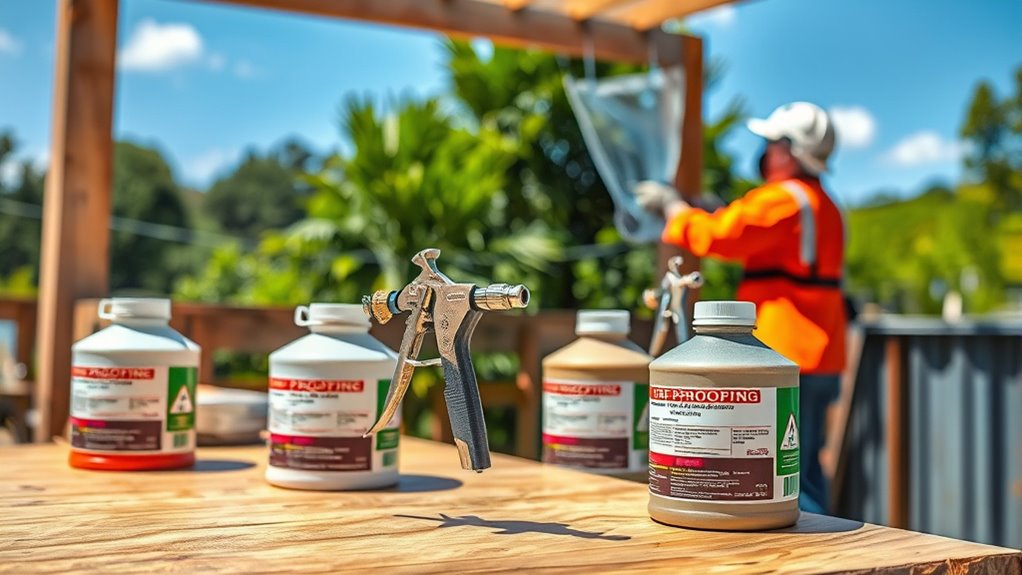To fireproof your outdoor projects safely, consider environmentally friendly flame retardant treatments that chemically alter materials to slow ignition and inhibit fire spread. These treatments work on wood, mulch, plants, and fabrics, creating a protective barrier without harmful fumes. Apply with brushes, sprayers, or dips, and remember to reapply regularly, especially after weather exposure. If you stay informed, you’ll discover effective, safe options to keep your outdoor spaces secure and resilient.
Key Takeaways
- Use fire-resistant coatings designed for outdoor surfaces like wood, metal, and masonry to create a durable, heat-resistant barrier.
- Apply environmentally friendly flame retardant treatments that chemically modify materials to slow ignition and flame spread.
- Choose products labeled as safe for outdoor use, complying with safety standards and offering protection against weather exposure.
- Regularly reapply fireproofing coatings and treatments to maintain effectiveness amidst weather and environmental factors.
- Incorporate fireproofing into routine outdoor maintenance to enhance landscape safety and meet fire safety regulations.

Outdoor projects can add beauty and functionality to your property, but they also come with fire risks, especially during dry seasons or in wildfire-prone areas. Protecting your outdoor spaces is essential, and one effective way is by using fireproofing techniques with safe chemical options. Fire resistant coatings and flame retardant treatments are designed to reduce the chance of fire spreading, giving you peace of mind while enhancing your landscape’s safety. These treatments form a barrier that slows ignition or prevents materials from catching fire easily, making them a smart investment for decks, fences, furniture, and other outdoor structures.
Fire resistant coatings are specially formulated paints or sealants you can apply directly to surfaces like wood, metal, or masonry. They are often clear or tinted, so they don’t compromise the aesthetic appeal of your garden or patio. When applied correctly, these coatings create a durable layer that withstands high temperatures and inhibits combustion. They’re especially useful for wooden structures or furniture that might otherwise ignite quickly during a fire. By providing an added layer of protection, fire resistant coatings can buy you precious extra minutes to evacuate or extinguish a fire before it causes significant damage.
Fire resistant coatings create durable, clear or tinted layers that protect wood, metal, and masonry from high temperatures and flames.
Similarly, flame retardant treatments work by chemically altering the materials they’re applied to, making them less likely to ignite or slow down the spread of flames. These treatments are versatile; you can apply them to mulch, grasses, plants, and even outdoor fabrics like cushions or umbrellas. They work by releasing flame-inhibiting gases when exposed to heat, which interfere with the chemical reactions needed for combustion. Flame retardant treatments are often environmentally friendly and designed to be safe for outdoor use, ensuring your landscape remains attractive and protected without introducing harmful chemicals.
Both fire resistant coatings and flame retardant treatments are easy to incorporate into your outdoor maintenance routine. They’re designed to be applied with brushes, sprayers, or dips, depending on the material. Regular reapplication is recommended to maintain their effectiveness, especially after weather exposure. When choosing these products, look for options that are labeled as safe for outdoor use and compliant with fire safety standards. Properly treated surfaces can considerably reduce fire hazards, giving you an extra layer of security during fire season.
Incorporating these chemical treatments into your outdoor projects isn’t just about compliance; it’s about proactively safeguarding your property and loved ones. By selecting the right fireproofing products, you ensure that your outdoor spaces remain beautiful and functional while minimizing fire risks. Utilizing fire safety standards and the latest fireproofing techniques can further enhance your landscape’s resilience. With fire resistant coatings and flame retardant treatments, you take responsible steps toward creating a safer, more resilient landscape.
Frequently Asked Questions
Are Chemical Fireproofing Treatments Environmentally Friendly?
You’re wondering if chemical fireproofing treatments are environmentally friendly. While some options may have eco-friendly alternatives, many traditional chemicals aren’t biodegradable and can harm ecosystems. To reduce your impact, look for treatments with chemical biodegradability and eco-friendly alternatives. These options break down more easily and pose less risk to wildlife and water sources. Always research products carefully to ensure you’re choosing fireproofing solutions that align with environmentally responsible practices.
How Long Does Chemical Fireproofing Last Outdoors?
You might think fireproofing lasts forever, but the truth is, durability estimates for outdoor chemical treatments vary. Weather resistance plays a big role, often reducing effectiveness over time. Typically, you can expect these treatments to last between 1 to 5 years, depending on exposure and product quality. So, while it might seem like a miracle, don’t forget to reapply to keep your projects truly protected from the elements.
Can Fireproofing Chemicals Be Applied to Existing Structures?
Yes, you can apply fireproofing chemicals to existing structures, especially for retrofit applications. To guarantee proper adhesion and effectiveness, you need to focus on surface preparation—cleaning, repairing, and sometimes priming the surface. This process helps the fireproofing chemicals bond well and provides maximum protection. Always follow manufacturer guidelines and consider consulting professionals for the best results, especially for critical or large-scale retrofit projects.
Are Fireproofing Chemicals Safe for Plants and Wildlife?
Imagine the unseen danger lurking around your outdoor projects. You wonder if fireproofing chemicals might harm plants or wildlife. While many options boast fireproofing safety, some chemicals can have a negative chemical impact on the environment. You must carefully choose fireproofing solutions, ensuring they’re non-toxic and eco-friendly. Protect your surroundings without risking harm—because true safety isn’t just about fire; it’s about preserving nature’s delicate balance.
What Maintenance Is Required for Chemical Fireproofing?
You should regularly perform maintenance on chemical fireproofing to guarantee safety and effectiveness. Follow the recommended maintenance frequency, which often involves inspections every 6 to 12 months. During inspection procedures, check for any signs of wear, damage, or degradation of the chemicals. If you notice issues, reapply or repair as needed. Consistent maintenance helps maintain fire resistance and prevents potential hazards over time.
Conclusion
By choosing safe chemical fireproofing options for your outdoor projects, you’re protecting both your space and loved ones. Did you know that untreated wooden structures can ignite in just 30 seconds during a wildfire? Using effective, eco-friendly fireproofing treatments can drastically reduce this risk, giving you peace of mind. So, take action today—safeguard your outdoor investments with the right chemicals, and guarantee your outdoor haven stays safe and beautiful for years to come.









